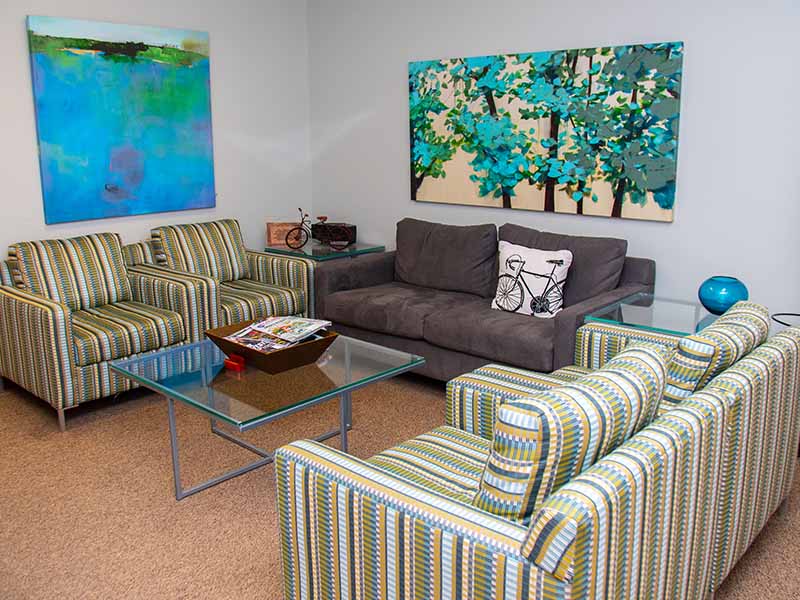Art Therapy at McCallum Place: An Overview
What is Art Therapy?
Art Therapy is a professional field that integrates creative expression and intersecting therapeutic theories grounded in research and years of practice. Art therapy aims to utilize art materials, the creative process, and artwork to explore emotions, build self-awareness around values and identity, reconcile conflict, tolerate discomfort, increase self-esteem, and so much more. Evidence to support the profession of art therapy spans research approaches, creating a foundation from which art therapists practice. The article written below provides a research-based lens of art therapy and how the creative process works within the treatment of eating disorders in hopes of providing a solid ground for future art therapy exploration.
Similar to other mental health professions, art therapy research is seeking to understand the mechanisms that support change in clients. Research defining the mechanisms of art therapy includes a neuroscientific understanding of the brain while making art[10], art materials on emotion regulation[13], group art therapy[6], eating disorders[22], and depression[4]. Current research delineates mechanisms of change specific to art therapy as mastery, viewing the art, mind-body work with art materials, and the pleasure and experimentation that comes from working with materials[3]. These are in addition to common factors in many other mental health fields such as a confiding healing setting, therapist’s actions, working alliance, and client’s change processes[11,12].
Within the art therapy and eating disorder research, art therapy aligned with Dialectical Behavior Therapy (DBT) can enhance comprehension and application of coping skills essential for effective eating disorder treatment [1]. The art and the art therapist’s use of self can become a conduit for empathic mirroring[18] and modeling mentalization[19], core tenants in somatic-based treatment for complex trauma[21,2,5].
Art Materials and the Creative Process
In Art Therapy, choosing the art materials and the process of making art is designed specifically for therapeutic interventions. Art therapists commonly refer to the Expressive Therapies Continuum (ETC)[8,15,14]. The ETC is a tool developed to organize art materials and expression into levels of complexity based on how they affect the brain. It assists in understanding how material choice and material usage are core considerations for eating disorder treatment. Namely, the ETC looks at the three brain networks activated by creativity (Executive Attention, Imagination, and Salience), which contain four of the nine regions suffering negative effects from malnourishment[7,17]. As a person experiencing malnourishment engages with the creative process, they have an opportunity to work through targeted layers of information processing and psychological activation.
According to the ETC, material selection, how materials are used, and symbolism within the artwork can indicate what level of cognitive function a person is experiencing. For example, if an individual engages with a scribbling action using oil pastels, their material choice and material usage could indicate engagement with both right and left brain functions through kinesthetic and sensory processing. This type of engagement with materials can lead to exploring preverbal information and somatosensory experiences in the right hemisphere of the limbic system[8,17]. As materials grow more resistive, the materials and how they’re used can elicit more sophisticated cognitive functions, such as symbolism and meaning-making[13].
Within the treatment of eating disorders, art therapy and its approach to dynamic information processing can assist participants with exploring defense mechanisms, tolerating discomfort, externalizing internal processes, and communicating through nonverbal expression, among other therapeutic outcomes. For example, for people experiencing eating disorders, control is often sought through eating-disordered behavior and protected by defenses such as rationalizations, persuasion, and intellectualization[9,20]. Art making, by nature, requires inner reflection and engagement with defenses. This, in turn, offers opportunities for clients to practice connecting the emotion with the intellect, radical acceptance, promote problem-solving, challenge perfectionistic tendencies, and engage in exposure therapy. Exposure therapy using art could look like the exploration of themes that evoke fear, using materials that elicit responses that feel unfamiliar or uncomfortable, and practice not being “perfect” in a supported environment[16].
A repeated phrase in the McCallum Place Art Room is, “It’s about the process, not the product.” This is true in that the product of the creative process does not provide a basis for assumptive assessments for the art therapist to conclude from (Ex: “You used the color blue, so you’re sad”). Rather, the product provides a platform for the clients to explore themes depicted and assign their meaning to what they create. It can provide reflective distance between the idea and the client to allow for internal exploration[18]. Additionally, the final art product can act as visual documentation chronicling changing beliefs, values, insights, and experiences throughout the treatment and recovery process.
Art Therapy at McCallum Place
Art Therapy is used in various ways in the treatment of eating disorders at McCallum Place. Trained art therapists work both individually and in group settings with patients at all levels of care. The use of art therapy is often used in combination with other therapeutic approaches or focuses of eating disorder treatment. For example, the following groups are currently offered within weekly programming: Art Therapy and DBT Coping Skills, Art Therapy and Body Image, Process Painting, Art Journaling, and Open Art Studio. Art therapy groups are held in a well-equipped art studio with a wide range of art materials and tools, including textiles, drawing mediums, paints, clay, and collage materials. McCallum Place’s art therapists focus their time on creatively exploring with patients using art and facilitated discussion to support the goals of recovery for the current and future clients seeking support.
For more information on McCallum Place’s Art Therapy treatment approach for eating disorders, please contact Kalen Smith, ATR, LPC (Kalen.Smith@mccallumplace.com) or Eva Sedjo, PLPC (Eva.Sedjo@mccallumplace.com) with your thoughts and/or questions.
References
[1] Clark, S. M. (2021). DBT in action: Art therapy and DBT skills training in treating eating disorders. In S. M. Clark (Ed.), DBT-Informed art therapy in practice (pp. 89-111). Jessica Kingsley Publishers.
[2] Courtois, F. A., & Ford, J. D. (2016). Treatment of complex trauma: A sequenced, relationship-based approach. The Guilford Press.
[3] de Witte, M., Orkibi, H., Zarate, R., Karkou, V., Sajnani, N., Malhotra, B., Ho, R. T., Kaimal, G., Baker, F. A., & Koch, S. C. (2021). From therapeutic factors to mechanisms of change in the Creative Arts Therapies: A scoping review. Frontiers in Psychology, 12. https://doi.org/10.3389/fpsyg.2021.678397
[4] Dunphy, K., Baker, F. A., Dumaresq, E., Carroll-Haskins, K ., Eickholt, J., Ercole1, M., Kaimal, G., Meyer, K., Sajnani, N., Shamir, O., & Wosch, T. (2019). Creative Arts Interventions to Address Depression in Older Adults: A Systematic Review of Outcomes, Processes, and Mechanisms.
[5] Fabrizio, L. (2021). Speaking out: Art therapy for trauma, eating disorders, and substance use disorders. In P. Quinn (Ed.), Art therapy in the treatment of addiction and trauma (pp. 153-171). Jessica Kingsley Publishers.
[6] Gabel, A., & Robb, M. (2017). (Re)considering psychological constructs: A thematic synthesis defining five therapeutic factors in group art therapy. The Arts in Psychotherapy, 55, 126-135. https://doi.org/10.1016/j.aip.2017.05.005
[7] Gotlieb, R. J. M., Hyde, E., Immordino-Yang, M. H., & Kaufman, S. B. (2018). Imagination is the seed of creativity. In J. C. Kaufman & R. J. Sternberg (Eds.), The Cambridge handbook of creativity (pp. 709-731). Cambridge University Press.
[8] Hinz, L. D. (2009). Expressive therapies continuum: A framework for using art in therapy. Routledge.
[9] Hinz, L. D. (2006). Drawing from within: Using art to treat eating disorders. Jessica Kingsley Publishers.
[10] King, J., Kaimal, G., Konopka, L., Belkofer, C., & Strang, C. (2019). Practical applications of neuroscience-informed art therapy. Art Therapy: Journal of the American Art Therapy Association, 36(3), 149-156. https://doi.org/1Practical Applications of Neuroscience-Informed Art Therapy0.1080/07421656.2019.1649549
[11] Lambert, M.J. & Ogles, B. M (2014). Common factors: Post hoc explanation or empirically based therapy approaches? Psychotherapy, 51(4), 500-504. https://doi.org/10.1037/a0036580
[12] Laska, K.M., Gurman, A.S., & Wampold, B.E., (2014). Expanding the lens of evidence-based practice in psychotherapy: A common factors perspective. Psychotherapy: Theory, Research, Practice, Training, 51 (4): 467-481. www.doi.org/10.1037/a0034332. PMID 24377408.
[13] Lusebrink, V. B., & Hinz, L. D. (2020). Cognitive and symbolic aspects of art therapy and similarities with large scale brain networks. Art Therapy: Journal of the American Art Therapy Association, 37(3), 113-122. https://doi.org/10.1080/07421656.2019.1691869
[14] Lusebrink, V. B., & Hinz, L. D. (2016). The expressive therapies continuum as a framework in the treatment of trauma. In J. L. King (Ed.), Art therapy, trauma, and neuroscience: Theoretical and practical perspectives (pp. 42–66). Routledge.
[15] Lusebrink, V. B. (2014). Art therapy and the neural basis of imagery: Another possible view. Art Therapy: Journal of the American Art Therapy Association, 31(2), 87–90. https://doi.org/10.1080/07421656.2014.903828
[16] Marmor, T. M. (2016). Body and self: The use of art therapy in eating disorder treatment. In A. Heiderscheit (Ed.), Creative arts therapies and clients with eating disorders. Jessica Kingsley Publishers.
[17] Misluk-Gervase, E. (2020). Art therapy and the malnourished brain: The development of the nourishment framework. Art Therapy: Journal of the American Art Therapy Association, 38(2), 87-97. https://doi.org/10.1080/07421656.2020.1739599
[18] Moon, C. H. (2010). Materials & media in art therapy: Critical understandings of diverse artistic vocabularies. Routledge.
[19] Moore, K., & Marder, K. (2020). Mentalizing in group art therapy: Interventions for emerging adults. Jessica Kingsley Publishers.
[20] Rehavia-Hanauer, D. (2003). Identifying conflicts of anorexia nervosa as manifested in the art therapy process. The Arts in Psychotherapy, 30(3), 137–149. https://doi.org/10.1016/S0197-4556(03)00049-2
[21] Siegel, D. J. (2010). The mindful therapist: A clinician’s guide to mindsight and neural integration. W. W. Norton.
[22] Sporild, I., & Bonsaksen, T. (2014). Therapeutic factors in expressive art therapy for persons with eating disorders. Groupwork. 24(1), 67-81. https://doi.org/10.1921/10201240104









